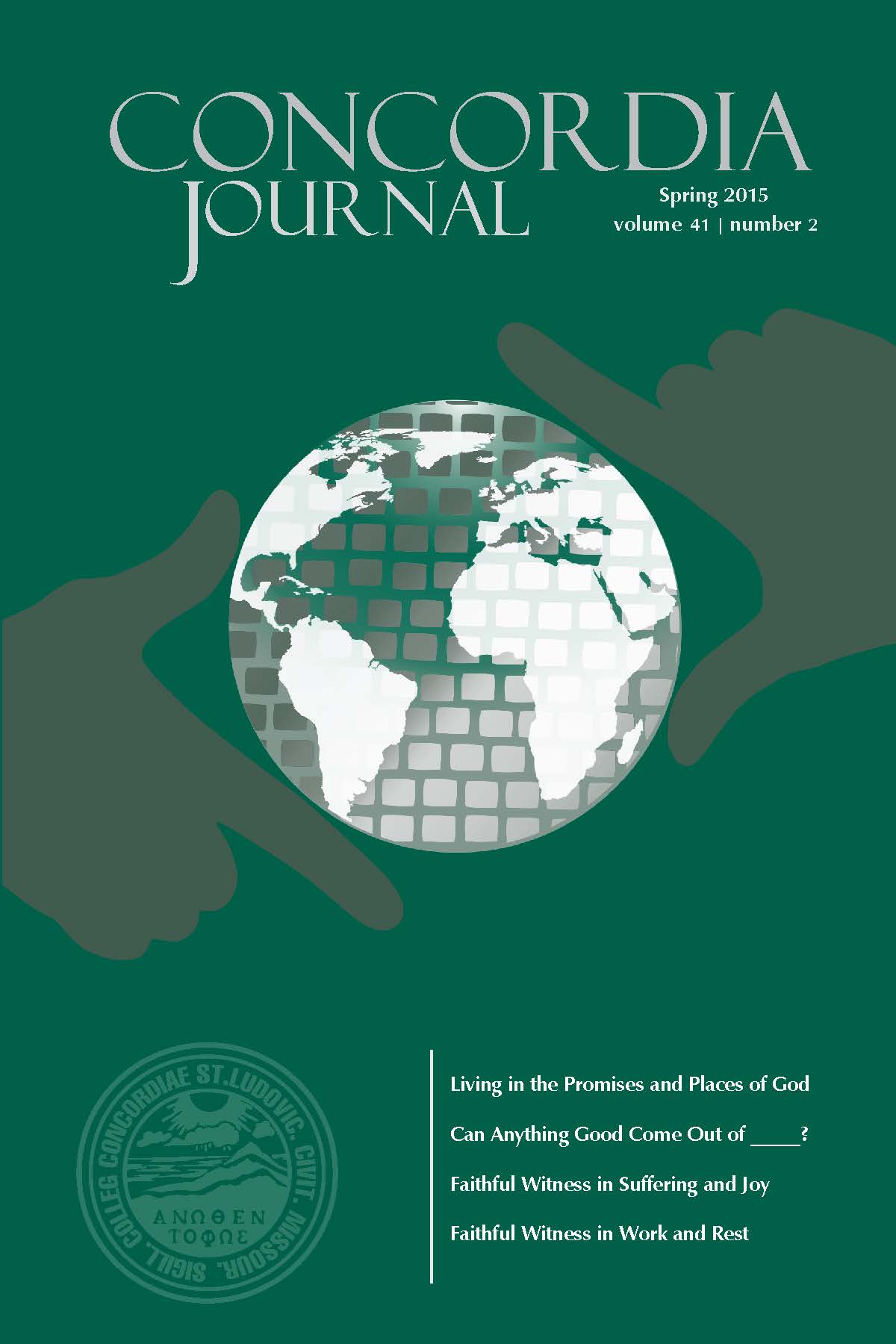Concordia Journal
Volume 41, Number 2 (2015)
As has become our custom, this spring issue of Concordia Journal publishes presentations from the preceding fall’s Theological Symposium. This is how the 2014 Symposium brochure characterized the theme “Faithful Witness to God’s Story in the World Around Us: Bringing a Unique Perspective to Common Human Experiences”:
When we view our Christian witness within the full shape of the biblical narrative, how does that shape our view of the world? One way is that we begin to see all human beings—Christian and non-Christian—and all of creation, as characters in the story of God. In this story, faithful Christian witness shares struggles and joys with all people, yet also points to hope for the fullness of life in Christ’s new creation.
This theme was an extension of, almost a sequel to, themes that arose from the 2013 Theological Symposium, “From the Creation to the New Creation: Seeing All Things in Light of the Entire Story.” If the 2013 Symposium explored the “entire story” of faith, the 2014 Symposium looked at how we bear witness to that story “in the world around us.” The key is to see how we give witness with others rather than simply give witness to them. This can become a first step in articulating how our shared experience fits within the singular story of God’s good news in Christ.
After college (before seminary), I worked for Leonard Fiedler, longtime educator and fundraising professional in The Lutheran Church—Missouri Synod. He was fond of saying that our work was done best when we worked with people “from the same side of the table.” I know now that his truism applies to a whole lot of situations. We often look at our interactions with others as if we’re on opposite sides of the table, as if the table were a chessboard. Turns out, though, that the conversation is more interesting—and more productive—when we look at things “from the same side of the table,” especially when we find hidden commonalities we never knew we had.
One of the ironies of pitting the “church” too strictly against the “world” is that it relieves the church of its own responsibility, its own complicity in what is happening in the world around it. In short, the church can rail against the world much more easily when it doesn’t bother to look in the mirror. Moreover, it short-circuits the joy of witnessing God’s left hand hidden but at work in our common humanity and in all of creation.
As Lutherans, we are fond of quoting our patron saint. One of my favorite commonplaces from Luther is this: “If you could understand a single grain of wheat, you would die of wonder.” Perhaps only when Christians share in this common human experience of deep wonder in even the tiniest things of this world will we gain enough of a footing with the others in our midst to be able to tell the full story—with confidence and integrity—of the One who likewise said, “Unless a grain of wheat falls into the earth and dies . . .” (Jn 12:24).
Editorial
More Lively Participation
Dale Meyer
Articles
Living in the Promises and Places of God
A Theology of the World
Charles Arand and Erik Herrmann
Can Anything Good Come Out of _____? Come and See!
Faithful Witness in Marginality and Hospitality
Leopoldo Sánchez
Faithful Witness in Suffering and Joy
Jeffrey Oschwald
Faithful Witness in Work and Rest
William Schumacher
Homiletical Helps
Pentecost • Acts 2:1–21 • May 24, 2015
Kent Burreson
Holy Trinity • Acts 2:14a, 22–36 • May 31, 2015
Erik Herrmann
Proper 5 • 2 Corinthians 4:13–5:1 • June 7, 2015
Michael Redeker
Proper 10 • Ephesians 1:3–16 • July 12, 2015
Timothy Dost
Proper 12 • Ephesians 3:14–21 • July 26, 2015
Benjamin Haupt
Proper 13 • Ephesians 4:1–16 • August 2, 2015
Richard Marrs
Book Reviews
NEGOTIATING IDENTITY:
Exploring Tensions between Being
Hakka and Being Christian in
Northwestern Taiwan
Henry Rowold

Editors
- Executive EDITOR
- Charles Arand Dean of Theological Research and Publication
- Managing Editor of Theological Publications
- Travis J. Scholl
- assistant editor
- Melanie Appelbaum
- assistants
- Andrew Hatesohl
- Andrew Jones
- Emily Ringelberg

